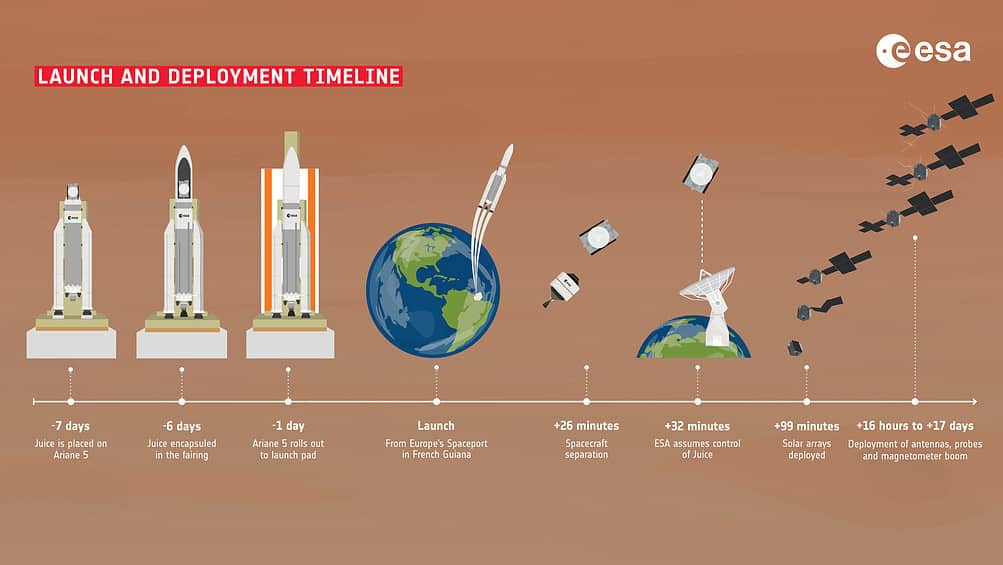
The European Space Agency (ESA) is set to launch the Jupiter Icy Moons Explorer (Juice) on 13 April 2023, targeting Jupiter’s largest moon, Ganymede, which may harbour a habitable underground ocean. The spacecraft will embark on a long, indirect flight, utilising gravity assists from Earth and Venus before arriving at Jupiter in 2031.
Juice will study Jupiter’s icy moons Europa, Callisto, and Ganymede, focusing on the latter’s unique magnetic field and the possibility of alien life in its subsurface waters. Equipped with cutting-edge instruments such as the high-resolution optical camera Janus, laser altimeter GALA, and ice-penetrating radar RIME, Juice aims to significantly expand our understanding of the Jupiter system. The mission will build on the accomplishments of previous probes and will work in synergy with NASA’s Europa Clipper, set to launch in 2023.
Jupiter’s Ocean Worlds: A Glimpse into the Habitability of Icy Moons
Jupiter’s icy moons, Ganymede, Europa, and Callisto, are thought to host buried oceans that could harbour the right conditions for life. ESA’s Jupiter Icy Moons Explorer (Juice) will be the first spacecraft to explore these moons in-depth, aiming to uncover the mysteries of these potentially habitable worlds. The mission represents the next logical step in the exploration of the outer solar system, according to Professor Emma Bunce, Director of the Institute for Space at the University of Leicester.
Scientists from the University of Leicester are among the international team participating in the Juice mission, utilising remote sensing and electromagnetic spectrum analysis to study Jupiter’s atmosphere, energy, and material flow. Professor Leigh Fletcher, an interdisciplinary scientist for the Juice mission, emphasises that the spacecraft provides a means of probing inside potentially habitable ocean worlds for the first time. If habitable environments are discovered, it could have profound implications for the search for life in our solar system.

Unlocking the Secrets of Ganymede, Callisto, and Europa
The Juice mission will characterise Ganymede, Callisto, and Europa using remote sensing, geophysical, and in situ instruments to uncover potential habitats for past and present life. The spacecraft will employ a multi-flyby approach, with dedicated orbits around Ganymede, and data collection is expected to begin in 2031.
Among the instruments on board Juice are the Moons and Jupiter Imaging Spectrometer (MAJIS), the UV imaging spectrograph (UVS), and the Juice magnetometer (J-MAG)[3]. MAJIS will observe cloud features and atmospheric constituents, as well as characterise ices and minerals on the icy moon surfaces. UVS will study Jovian aurorae and investigate the planet’s upper atmosphere composition and structure, while J-MAG will characterise the Jovian magnetic field and its interaction with Ganymede, as well as study the subsurface oceans of the icy moons.

Building on Previous Discoveries and Collaborating with Future Missions
Juice will build on the accomplishments of previous missions, such as NASA’s Pioneer 10, Voyager spacecraft, Galileo, and Juno, which have provided valuable insights into Jupiter’s atmosphere, magnetic field, and mysterious auroras[1]. The spacecraft will work in synergy with NASA’s upcoming Europa Clipper, set to launch in 2023 and arrive in 2030, enhancing our understanding of the Jovian system.
At the end of its mission, Juice will meet a dramatic end, much like the Galileo and Cassini probes before it, by plummeting into Ganymede’s surface. This will prevent space debris and ensure that the spacecraft completes its mission in a responsible and impactful manner. As scientists eagerly anticipate the launch of the Juice mission, the exploration of Jupiter’s ocean worlds promises to reveal new insights into the potential for life beyond Earth and the habitability of icy moons in our solar system.
Sources Laio used to write this article:
– Leicester scientists on Jupiter moon mission look ahead to launch date.
– A European Space Probe Sets Its Sights on the Jupiter System.
– The JUICE mission to explore Jupiter’s ocean moons is about to launch.

